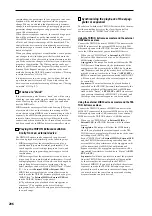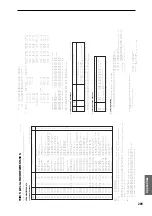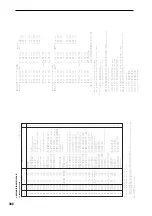
289
Appendices
Connections using the USB B connector
Connect the TRITON Extreme’s USB B connector to the USB
port of your computer, and make the appropriate driver set-
tings.
For details on the types of computer and operating sys-
tem that the TRITON Extreme supports, refer to p.325.
Local Control On settings
When connections are made as shown above, turn on the
Echo Back function of the external MIDI sequencer or com-
puter (so that data received at MIDI IN will be re-transmit-
ted from MIDI OUT), and turn off the TRITON Extreme’s
Local Control
setting (so that the TRITON Extreme’s key-
board and tone generator will be internally disconnected).
When you play the keyboard of the TRITON Extreme, the
musical data will be transmitted to the external MIDI
sequencer or computer, and then echoed back to play the
TRITON Extreme’s tone generator. In other words, by turn-
ing Local Control OFF, you can prevent notes from being
sounded in duplicate, as would otherwise occur if a note
were sounded by the TRITON Extreme’s own keyboard and
again by the data that was echoed-back.
If the arpeggiator function is on, playing the TRITON
Extreme’s keyboard will not cause the arpeggiator to oper-
ate, and only the musical data produced by playing the key-
board will be transmitted. The arpeggiator will operate only
in response to the notes that are echoed-back and received at
MIDI IN. In this way, turning off Local Control prevents the
arpeggiator from operating in duplicate.
Use this setting when you wish to record on the external
MIDI sequencer or computer only the notes that trigger the
arpeggiator, and to use the echoed-back notes to operate the
arpeggiator while monitoring your recording or during
playback.
If you want the note data produced by the arpeggiator
to be recorded on the external sequencer/computer, set
Local Control on, and turn off the Echo Back setting of
the external sequencer/computer.
To turn off Local Control, press the “Local Control On”
(Global P1: 1–1a) check box to uncheck it.
When using the TRITON Extreme by itself, leave Local Con-
trol turned on. (If this is off when the TRITON Extreme is
used by itself, playing the keyboard will not produce
sound.)
■
Messages transmitted and received
by the TRITON Extreme
[...] indicates hexadecimal notation
MIDI channels
MIDI messages can be exchanged when the transmitting
and receiving devices are set to the same MIDI channel.
MIDI uses sixteen channels, numbered 1–16. The way in
which channels are handled will differ depending on the
mode.
Program mode and Sampling mode
• Transmission/reception is performed on the global
MIDI channel*.
* The global MIDI channel is the basic channel that the
TRITON Extreme uses for MIDI transmission/reception,
and is set by “MIDI Channel” (Global P1: 1–1a).
Combination mode
• The global MIDI channel is used to transmit/receive
messages for selecting a combination and turning effects
on/off, and to transmit/receive exclusive data.
• Each timbre will transmit/receive MIDI data on the
“MIDI Channel” (Combination P2: 2–1b) that is specified
for that timbre.
• The “Ctrl Ch” MIDI channel specified for each effect
(“Combination P8: 8–3a, P9: 9–2a, 9–4a) is used to
control dynamic modulation of the insert/master effects,
the pan following the insert effect, and send 1 and 2.
• When you operate the keyboard or controllers of the
TRITON Extreme, messages will be transmitted on the
global MIDI channel, and will also be transmitted on the
MIDI channel of any timbre whose “Status”
(Combination P2: 2–1b) is set to EXT or EX2.
• Channel messages will be received if they match the
MIDI channel of a timbre whose “Status” is set to INT
(
☞
Combination P2: 2–1b).
Sequencer mode and Song Play mode
• The global MIDI channel is used to transmit/receive
exclusive data and for messages that switch effects on/
off.
• MIDI data transmission/reception for each track will
occur on the MIDI channel specified for each track by
“MIDI Channel” (Sequencer P2: 2–1a/2a).
• The “Ctrl Ch” MIDI channel specified for each effect
(“Sequencer P8: 8–3a, P9: 9–2a, 9–4a) is used to control
dynamic modulation of the insert/master effects, the
pan following the insert effect, and send 1 and 2.
• When you operate the keyboard or controllers of the
TRITON Extreme, messages will be transmitted on the
MIDI channel selected by “Track Select” (Sequencer P0:
0–1a) However, messages will be transmitted only if the
track selected by “Track Select” has a “Status” of BTH,
EXT
, or EX2. (“Track Select”
• When the sequencer is played back, musical data of
tracks whose “Status” is BTH, EXT, or EX2 will be
transmitted on the specified MIDI channels.
• Tracks whose “Status” is INT or BTH will receive
channel messages of the matching MIDI channel
(
☞
“Status,” “MIDI Channel”
Note on/off
Note-on [9n, kk, vv]
Note-off [8n, kk, vv]
(n: channel, kk: note number, vv: velocity)
When you play a note on the TRITON Extreme’s keyboard,
it will transmit note-on/off messages. When the arpeggiator
is running, note-on/off messages will be transmitted by the
MIDI
IN
MIDI
OUT
MIDI
OUT
MIDI
IN
computer
TRITON
Extreme
USB B
USB cable
Summary of Contents for TRITON Extreme
Page 1: ...2 E ...
Page 11: ...xii ...
Page 111: ...100 9 5 Page Menu Command 0 1A 0 1I 0 1J Program 9 5A ...
Page 185: ...174 ...
Page 215: ...204 ...
Page 281: ...270 ...
Page 349: ...338 ...
Page 350: ...339 ...
Page 351: ...340 ...
Page 352: ...341 ...
Page 353: ...342 ...






























